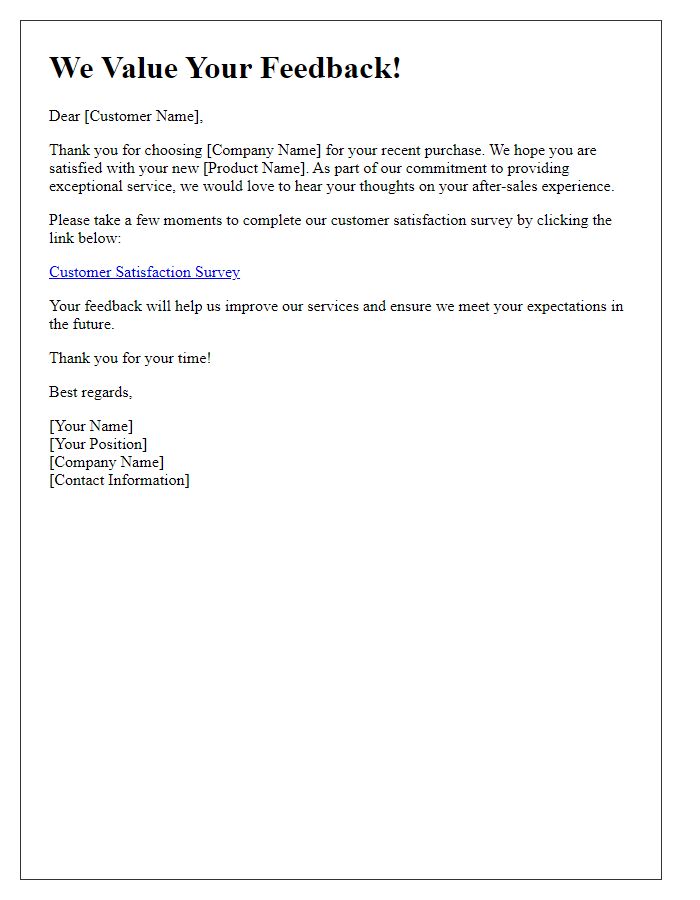Hey there! If you're looking to gather valuable insights on your after-sales service, crafting the perfect feedback letter can make all the difference. It's a fantastic way to engage with your customers, by not only seeking their opinions but also showing them that their thoughts matter. Want to learn more about how to create an effective after-sales service feedback letter? Keep reading!

Personalization
Personalized after-sales service feedback enhances customer experience, fostering brand loyalty. During interactions, utilizing the customer's name increases engagement. Addressing specific purchase details, such as model names or order numbers, adds relevance. Tailoring feedback requests to customer behavior, such as recent purchases or website interactions, makes them feel valued. Acknowledging previous inquiries or issues can communicate attentiveness and responsiveness, showing that the brand cares about long-term relationships. Overall, personalized communication can dramatically improve customer satisfaction and retention rates, ensuring clients feel recognized and appreciated.
Clear purpose
After-sales service feedback serves to enhance customer satisfaction, reflecting a company's commitment to quality. Customers' experiences can vary widely; for instance, a recent interaction might reveal either a seamless resolution (such as receiving a replacement within 48 hours) or delays (lasting over a week for an essential product). Addressing specific aspects like product functionality (defects reported in a model), responsiveness (customer service availability during business hours), and overall experience (consideration of feedback in product design) is crucial. This feedback process not only informs product improvements but also fosters a sense of loyalty and brand trust among consumers, particularly in competitive markets.
Specific questions
After-sales service feedback is essential for enhancing customer experience and improving product quality. Key aspects often include response times to queries, effectiveness of solutions provided, and overall satisfaction with the interaction. For instance, customers might be asked to rate their level of satisfaction on a scale from 1 to 5 in categories such as clarity of communication, professionalism of the service agent, and the promptness of service. Additionally, specific questions can target areas like issues resolved on the first contact, ease of reaching customer support, and willingness to recommend the service to others. Feedback collection methods, such as follow-up surveys or direct communication via email, can significantly contribute to gathering valuable insights into customer experiences and service performance.
Polite tone
After-sales service feedback is crucial for companies aiming to improve customer satisfaction. Collecting insights from customers, such as their experiences with response times (typically under 48 hours), issue resolutions, and overall service quality can help businesses enhance their support systems. Customers may refer to specific service agents by name, share their feelings about prompt follow-ups, and detail any positive or negative interactions they faced. In many cases, customers provide suggestions for improvement, making their feedback invaluable for continuous service development and fostering stronger customer relationships.
Contact information
Feedback on after-sales service reveals critical insights into customer experience with products and services. Collecting contact information such as names (individual or corporate), emails (typically in formats like name@domain.com), and phone numbers (including country codes for international clients) is essential. Gathering customer opinions through surveys or direct communication aids businesses in evaluating performance metrics. Metrics such as response time (ideal under 24 hours) and resolution rate (aiming for over 90%) help identify areas for improvement. Implementing feedback can strengthen brand loyalty and enhance service quality in competitive markets.
Letter Template For After-Sales Service Feedback Samples
Letter template of feedback request regarding after-sales service quality

Letter template of comments and suggestions for after-sales interactions












Comments